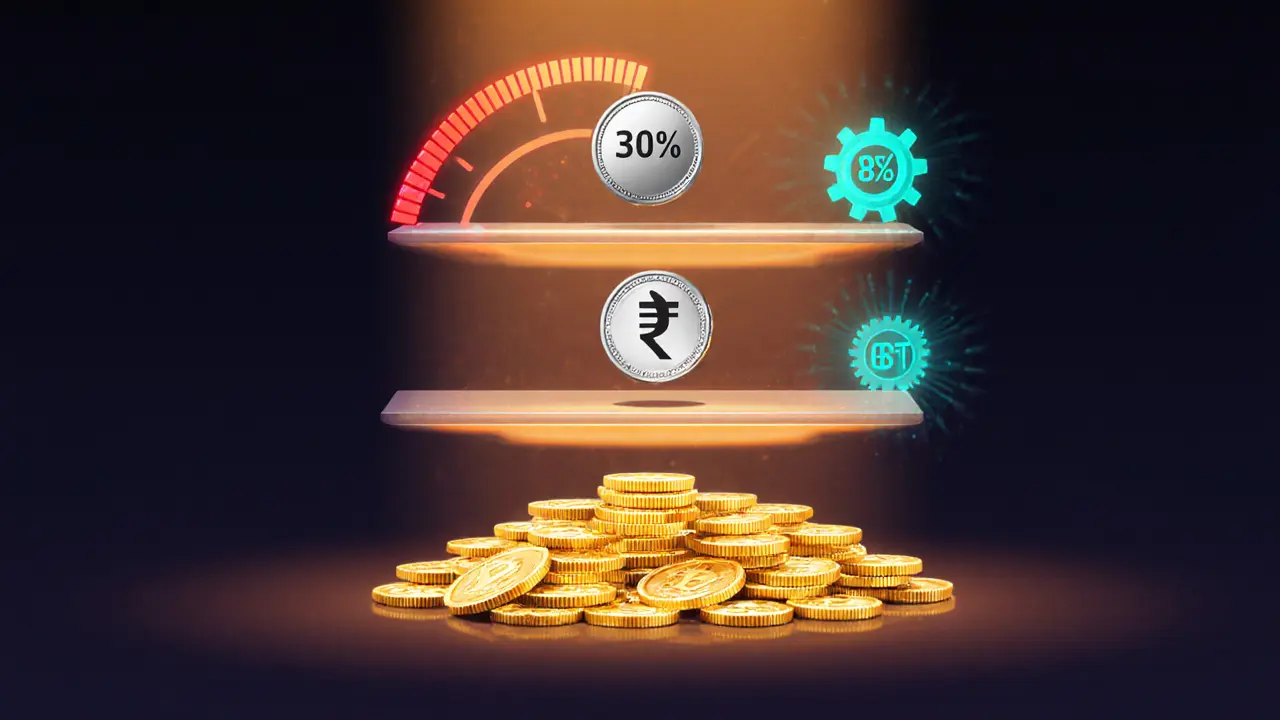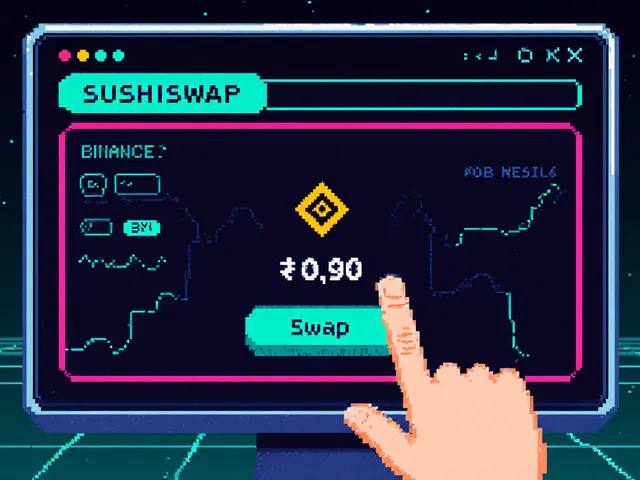India Crypto Tax Calculator
Calculate Your Crypto Tax Liability
Enter your crypto transaction details to calculate tax, TDS, and GST components.
Tax Breakdown
Gross Profit:
30% Tax:
1% TDS (if applicable):
18% GST (on exchange fee):
Total Tax Liability:
Effective Tax Rate:
When India's 30% cryptocurrency tax is a flat levy on all gains from virtual digital assets introduced by Section 115BBH of the Income Tax Act in April 2022, Bitcoin traders suddenly faced a tax bill that rivals the highest rates worldwide.
TL;DR
- Flat 30% tax on any crypto profit, plus 1% TDS and 18% GST on exchange fees.
- Only the purchase price is deductible; transaction fees can’t be claimed.
- Losses can’t offset gains, nor be carried forward.
- Report gains in Schedule VDA of your ITR; TDS applies after ₹50,000 annual turnover.
- Consider using tax software like ClearTax or Koinly to stay compliant.
What the 30% Rate Means for Bitcoin Traders
The tax treats every crypto transaction as a taxable event, regardless of whether you’re a short‑term trader or a long‑term holder. The calculation is simple on paper but can become messy in practice:
Tax Liability = (Selling Price - Purchase Price) × 30%
For example, if you sell 0.5BTC for ₹5,00,000 having bought it for ₹3,00,000, the taxable gain is ₹2,00,000. At 30%, you owe ₹60,000 in tax, plus any applicable surcharge and 4% cess, pushing the effective rate to about 31.2%.
Key Components of the Tax Framework
India crypto tax is not just the 30% income‑tax component. Three layers stack up:
- Tax Deducted at Source (TDS) a 1% deduction on crypto transfers that exceed ₹50,000 in a financial year (₹10,000 for certain payments). The exchange must withhold this amount and remit it to the government.
- Goods and Services Tax (GST) an 18% tax on the service fee charged by crypto exchanges, introduced in July 2025. This is payable by the user to the exchange, not directly to the tax department.
- The flat 30% income‑tax rate applied on the net profit from each virtual digital asset.
Defining the Assets: Virtual Digital Assets (VDAs)
The Virtual Digital Assets (VDAs) a term codified in Section 2(47A) of the Income Tax Act covering cryptocurrencies, NFTs, tokens and other digital assets are the only assets subject to the 30% rate. Traditional financial instruments like stocks or bonds remain under regular capital‑gains rules.
What You Can (and Cannot) Deduct
Only the original purchase price qualifies as a deductible expense. This means:
- No claim for exchange transaction fees, wallet security costs, or gas fees.
- No allowance for loss‑offsetting across different cryptocurrencies.
- Losses cannot be carried forward to the next financial year.
Consequently, a trader who loses ₹30,000 on Bitcoin but gains ₹30,000 on Ethereum still owes tax on the Ethereum profit (₹9,000 at a 30% rate).

Reporting Requirements: Schedule VDA
From FY2022‑23 onward, every taxpayer must disclose crypto activity in the newly introduced Schedule VDA a specific schedule in the Indian income‑tax return for reporting gains and losses from virtual digital assets. Failure to file can attract penalties and interest.
Typical data points needed per transaction:
- Date of acquisition and sale.
- Quantity of Bitcoin (or other VDA) transferred.
- Purchase price in INR (or foreign currency converted at prevailing rate).
- Sale price in INR.
- Any TDS already deducted (Form26AS).
For a simple buy‑and‑hold investor, this may take 10‑15hours a year. Active traders often spend 40‑50hours, especially when juggling multiple exchanges.
Compliance Tools: ClearTax and Koinly
Two home‑grown platforms have built India‑specific modules:
- ClearTax an Indian tax‑filing service that now includes automated VDA reporting and TDS reconciliation.
- Koinly a global crypto tax calculator that updated its engine in September2025 to handle the 30% rate, TDS, and GST.
Both tools import CSV statements from exchanges, compute the taxable profit, and generate the Schedule VDA ready for upload.
How India Stacks Up Globally
| Country | Tax Rate | Loss Offsetting | TDS/Withholding |
|---|---|---|---|
| India | 30% flat (≈31.2% with surcharge/cess) | Not allowed | 1% TDS on ₹50k+ transfers |
| United States | 0%/15%/20% long‑term, 22%‑37% short‑term | Allowed | No TDS |
| Germany | 0% after 1‑year hold, otherwise personal income tax | Allowed | No TDS |
| Singapore | No capital‑gains tax | Irrelevant | No TDS |
| United Kingdom | 10%/20% depending on income bracket | Allowed | No TDS |
The Indian framework is unique in three ways: a uniform flat rate, absolute prohibition on loss set‑off, and an automatic 1% TDS. For active traders, the cumulative burden can exceed 40% of net gains.
Practical Tips to Reduce Your Tax Bill
- Consolidate exchanges. Fewer platforms mean fewer CSV files and easier cost‑basis tracking.
- Use FIFO or specific identification. While the law only recognises purchase price, choosing a consistent accounting method helps avoid disputes.
- Plan withdrawals. Keep annual crypto‑related transactions below the ₹50,000 TDS threshold when possible.
- Factor in GST. When budgeting for trades, add 18% on the exchange fee to your cost basis.
- Seek professional help. If you trade more than 10times a month or hold assets across wallets, a chartered accountant familiar with Schedule VDA can save you hours and potential penalties.
Future Outlook
Since July2025 the government has clarified GST applicability, but no amendment has softened the 30% rate or the loss‑offset ban. Industry analysts expect possible tweaks to the TDS threshold or a separate slab for high‑frequency traders, yet any change would require a new budget announcement.
Meanwhile, many Indian traders are migrating to offshore exchanges that claim to be outside the tax net, though this raises AML and compliance concerns. The Reserve Bank of India and SEBI are reportedly drafting a broader digital‑asset regulatory framework that may integrate tax reporting directly into exchange licensing.
Frequently Asked Questions
Do I need to pay tax if I only hold Bitcoin and never sell?
No. Tax is triggered only on a transfer that results in a sale or exchange for another asset. Simply holding Bitcoin without a taxable event incurs no 30% charge.
Can I offset a loss on Bitcoin against a profit on Ethereum?
No. The law treats each Virtual Digital Asset separately. Losses in one VDA cannot reduce tax on another, nor can they be carried forward.
How is the 1% TDS collected?
When you sell or transfer crypto worth more than ₹50,000 in a financial year, the exchange deducts 1% at the source and deposits it with the Income Tax Department. The amount appears in Form26AS and is credited against your final tax liability.
Do transaction fees count as a deductible expense?
No. The only deductible cost is the original purchase price. Fees, gas, or withdrawal charges cannot be claimed.
Is GST paid to the government or the exchange?
GST is levied on the service fee charged by the exchange. The exchange collects the 18% and remits it to the government; you don’t file GST yourself for crypto trades.







Parker Dixon
April 16, 2025 AT 15:53Hey fellow traders 😊, the 30% flat crypto tax in India really changes the game for anyone flipping Bitcoin. You’ve got the basic formula right – (sale‑price – purchase‑price) × 30% – but remember the extra 1% TDS once you cross ₹50k in a year. Also, that 18% GST on exchange fees can sneak up on you if you’re not tracking the fee side. Most platforms now give you a CSV export, so feeding that into ClearTax or Koinly saves you a ton of manual work. Bottom line: treat every sell as a taxable event and keep good records, and the headache stays manageable.
Katrinka Scribner
April 17, 2025 AT 05:47Thiss iis sooo confusing 😂
VICKIE MALBRUE
April 17, 2025 AT 19:40Stay positive keep learning the tax rules are tough but you can handle it
Waynne Kilian
April 18, 2025 AT 09:33It feels like the tax code is a maze, but if you map your transactions like a philosopher maps thoughts, you’ll find a path. The flat 30% seems harsh, yet it’s consistent – no room for loss set‑off, which can feel unfair. My advice: consolidate exchanges so you have fewer CSVs to juggle, that way the bookkeeping becomes less of a nightmare. Also, keep an eye on the 1% TDS threshold; a few small trades can slip you over without you noticing. Sorry for the typos – the stress of numbers got to me.
Naomi Snelling
April 18, 2025 AT 23:27Honestly, the whole thing smells like a ploy to push traders offshore where they can hide. Those 1% TDS and GST on fees are just layers to make compliance unbearable, forcing people to look for “off‑shore” platforms that claim to be out of reach of the Indian tax man. Keep your eyes open – every new rule seems designed to squeeze you tighter.
Michael Wilkinson
April 19, 2025 AT 13:20Listen, the tax is what it is – you either accept it or you get penalized. Don’t try to dance around the 30% and the GST; the government will catch you eventually.
Billy Krzemien
April 20, 2025 AT 03:13For anyone new to this, treat the tax filing like a personal project. First, gather all your exchange statements – most platforms now support direct export to CSV or Excel. Next, import those files into a tool like ClearTax; it will auto‑populate Schedule VDA for you. If you’re juggling multiple wallets, label each transaction with the exchange name to avoid duplicate entries. Finally, double‑check the TDS entries on Form 26AS – they should already be reflected as prepaid tax. Following these steps saves time and reduces the risk of costly errors.
april harper
April 20, 2025 AT 17:07The drama of a 30% tax feels like a tragic opera, yet we keep dancing on the stage.
Clint Barnett
April 21, 2025 AT 07:00Alright, let’s break this down piece by piece because the Indian crypto tax regime is a beast that needs a thorough dissection. First, the flat 30% rate applies to every profit you make on a virtual digital asset, regardless of how long you held it; there is no distinction between short‑term and long‑term gains, which is unlike many other jurisdictions. Second, you cannot offset losses from one cryptocurrency against gains from another – each VDA is treated in isolation, meaning a Bitcoin loss won’t help your Ethereum profit. Third, the only deductible amount is the purchase price; all exchange fees, gas, and even wallet security costs are non‑deductible, inflating your taxable base. Fourth, the 1% Tax Deducted at Source (TDS) comes into play once your annual crypto transaction volume crosses ₹50,000, and the exchange is obligated to withhold and remit that amount to the tax department. Fifth, the 18% GST is levied on the exchange’s service fee, which the exchange collects and pays to the government – you as the trader don’t file GST, but the fee effectively raises your cost basis. Sixth, you have to report everything in Schedule VDA of your income‑tax return, supplying dates, quantities, acquisition and disposal values, and any TDS already deducted, which can be a daunting spreadsheet task for active traders. Seventh, the compliance tools ClearTax and Koinly have built specific modules for India’s rules, allowing you to import CSVs and generate the required Schedule VDA automatically, which is a lifesaver for anyone with more than a handful of trades. Eighth, remember that losses cannot be carried forward; a bad year cannot be used to offset a good year, so strategic planning around the ₹50,000 TDS threshold can actually save you money. Ninth, the government has hinted at possible tweaks, but as of now the core structure – flat 30%, no loss set‑off, and mandatory TDS – remains unchanged. Finally, if you’re serious about trading, consider consulting a chartered accountant familiar with VDA reporting to avoid penalties and ensure you’re not overpaying. In short, the Indian crypto tax is unforgiving but manageable with the right tools and disciplined record‑keeping.
Jacob Anderson
April 21, 2025 AT 20:53Oh great, another 30% tax. Because nothing screams innovation like a flat rate that makes every crypto enthusiast reconsider their life choices.
Kate Nicholls
April 22, 2025 AT 10:47The system does feel heavy, but at least it’s transparent. If you keep good records, you won’t be caught off guard.
Sidharth Praveen
April 23, 2025 AT 00:40Keep your head up! The tax looks scary, but with a solid tracking habit you’ll stay ahead. Use the tools, stay organized, and you’ll avoid surprises.
Stefano Benny
April 23, 2025 AT 14:33From a contrarian POV, the 30% flat could actually level the playing field – it removes the advantage of long‑term holding strategies that benefit only the wealthy. Sure, it stings now, but maybe it forces the market to innovate on compliance tech faster. 🤔
Bobby Ferew
April 24, 2025 AT 04:27Honestly, the whole tax framework feels like an over‑engineered nightmare, especially when you consider the hidden costs of GST on fees. It’s a pain, but you’ve got to deal with it.
celester Johnson
April 24, 2025 AT 18:20One could argue that taxes are the price of civilization, yet the 30% rate feels more like a punitive levy than a civic duty. It forces us to contemplate the balance between personal liberty and societal contribution.
Prince Chaudhary
April 25, 2025 AT 08:13Stay compliant, friends. Use a single reputable exchange, keep your CSVs tidy, and file Schedule VDA on time. It’ll spare you headaches later.
John Kinh
April 25, 2025 AT 22:07Another day, another tax headache – why even bother?
Mark Camden
April 26, 2025 AT 12:00It is incumbent upon every responsible taxpayer to meticulously document all crypto transactions, ensure timely TDS remittance, and adhere to the Schedule VDA filing requirements. Failure to do so may result in punitive actions and interest accruals, which are avoidable through diligent record‑keeping.
Evie View
April 27, 2025 AT 01:53Enough with the excuses – if you’re trading you’re already making money, so pay the tax.
Kate Roberge
April 27, 2025 AT 15:47Honestly, the 30% flat tax is just a bluff to keep us all in line. You can’t cheat the system forever.
Oreoluwa Towoju
April 28, 2025 AT 05:40Use one exchange, export CSV, plug into ClearTax – simple.
Jason Brittin
April 28, 2025 AT 19:33Clint, that was a marathon of a comment – love the detail! 😂 Just remember to actually double‑check the GST on your exchange fees, it can sneak up on you.